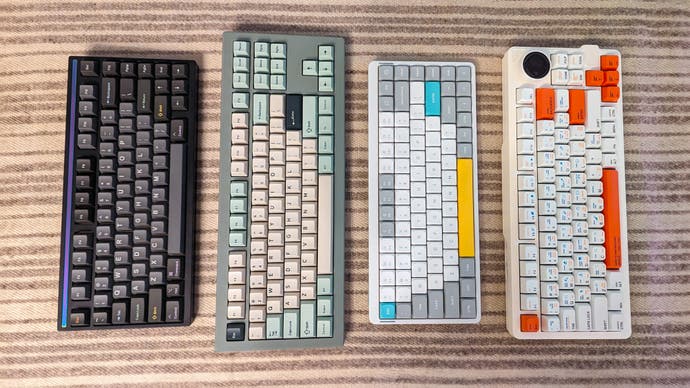Charting the state of the art in mechanical keyboards: winter 2023 mini reviews
Nuphy Air75 V2, Gamakay LK75, Drop CSTM80 and Mode Sonnet compact keyboards tested.
Another season has arrived, and with it a host of exciting new mechanical keyboards. Here are quick-fire reviews of four favourites that I've tested over the past month, from two extremely good value options with both niche and mass-market appeal (the trendy Nuphy Air75 v2 and odd Gamakay LK75) to two of the most customisable and expensive keyboards I've ever tested (the fancy Drop CSTM80 and the godlike Mode Sonnet).
Beyond the usual key feel impressisons and longevity stats cited by mechanical keyboard enthusiasts, the strength of this category is that there is just so much you can do to tweak and customise every aspect of your keyboard, from keycaps and switches to more subtle elements like plates, weights, foam and cases. This quartet demonstrates that flexibility ably, and while certain trendy features like gasket-mounted switches are included more or less throughout, there are also some new options I've not seen in mainstream gaming keyboards - so take a look if you want to see what Corsair, SteelSeries and Razer will be offering in a few years' time!
Use the links below to jump to just the keyboard you're interested in, or scroll on to see the full holiday assortment.
- Nuphy Air75 V2 review: transformative upgrades to what was already a top value keyboard
- Gamakay LK75 review: a kooky Photoshop-oriented keyboard with a big knob
- Drop CSTM80 review: a highly customisable keyboard with case, weight and plate options
- Mode Sonnet review: the nicest - and most expensive - keyboard I've ever used
Nuphy Air75 V2 review: transformative upgrades to an already excellent value low-profile wireless keyboard

We're currently recommending Nuphy's Air, Field and Halo keyboards in various Digital Foundry guides, so I was keen to take a look at the firm's recently released Air V2 board to see what's changed. In short, the new keyboard now boasts a semi-transparent bottom cover (with colour-coordinated internals), 1000Hz polling over 2.4GHz (equalling most gaming keyboards, double the rate of the V1) and other input lag optimisations, 2.2x more battery life in Bluetooth mode, open source QMK/VIA firmware support (allowing customisation via web browser!), PBT keycaps, new switch options, and even redesigned bottom feet that allow for use directly on top of the latest MacBook keyboards.
Taken separately, these are nice changes that will make a big difference for some users, but combined they produce a significantly better product for basically everyone - and it's therefore easy to recommend the Air75 even more strongly than its predecessor. While the other keyboards in this round-up are situationally excellent, the Air75 is a cut above and just offers so much quality for what you're paying.
This is a keyboard that I kept on my desk for far longer than was necessary to review it, just because I enjoyed using it so much. Having low-profile keycaps with short-throw soft linear switches beneath makes for a keyboard I can type on with extreme speed and precision - unlike most laptop keyboards - and the keyboard is still light and slim enough that it's not a problem to toss it into my backpack to use while on the road. That makes the Air75 V2 my top recommendation in this round-up.
Gamakay LK75 review: a kooky Photoshop-oriented keyboard with a big screen-equipped volume knob
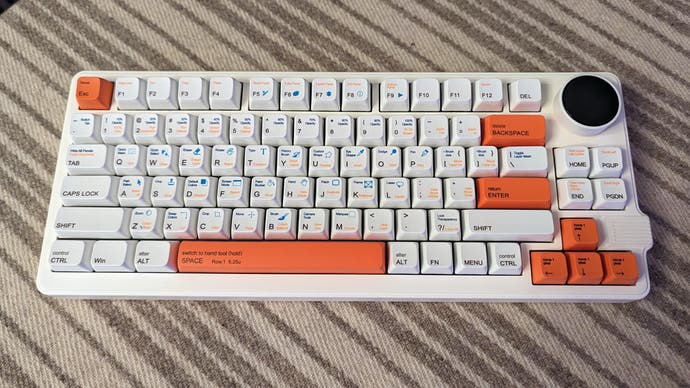
This £82 keyboard comes with a circular LED display in the upper right, box-style mechanical switches and a unique 75 percent layout, but what I want to talk about are the absolutely bonkers keycaps. As well as coming in a white/orange colour scheme with a more rounded shape, it feels like every square millimetre of available space here is filled up with Photoshop-specific labels, which gives the keyboard a slightly frantic vibe.
Some of this stuff is genuinely great for newer Photoshop users - I never expected that Home and End would allow me to view the top left and bottom right corners of an image, for instance - but you also have arrow keys that are printed with the tex "move one pixel" and Control keys labelled with both "CTRL" and "Control". I particularly like the printed icons on many of the alphanumeric keys, which match up with the various tools available - eraser, paint bucket, hand, lasso and so on. After seeing a ton of keyboards with very deliberately minimalist legends, it's actually quite nice to see something so densely packed with information - and the legends themselves are all spelled correctly, colour-coordinated to distinguish primary and secondary functions and generally done to a high standard with PBT construction.
Elsewhere, the LK75 is well-appointed and quirky, with a concealed 2.4GHz wireless USB dongle bulging out of the right-hand side, plus Bluetooth and USB-C support, hot-swappable switches (quiet tactile "Pegaus" switches for me), Windows/Mac modes, silicone/PET noise dampening, RGB backlighting and software for reprogramming keys. (I also like that the box specifies that "water and beverages can't be poured into the keyboard" - always good to know for sure.)
The LED display is the only real flop out of the box, with an ugly, low-res default display that shows the time/date in China, battery life, a Gamakay logo and whether you're in Mac or Windows and wired, 2.4GHz or Bluetooth modes. However, using the Gamakay software it is at least quick and easy to replace this with a custom still or animasted image of your choice - I went for a bespoke design created by a member of Digital Foundry Supporter program which looked pretty neat in my estimation, and the keyboard even accepted a two-second 60fps GIF of the Digital Foundry intro sequence. Amusingly, you can share images, lighting patterns, macros and keymaps with other users in a community tab of the software, which is a cool idea that won't be copied by Western brands due to the obvious moderation issues.
While the professional Photoshop legends and gamer-friendly RGB backlighting plus animated-GIF screen are kind of at odds with one another, the LK75 is a genuinely solid keyboard that is quite and plesant to type on. If the layout, colour scheme and at least one of its core features appeal to you, then it could be worth a look, but this certainly isn't a keyboard with mainstream appeal.
Drop CSTM80 review: a highly customisable keyboard with case, weight, plate, switch and keycap options

Drop makes a good range of mechanical keyboards these days, with designs that tend to be nicely customisable with enthusiast-grade switches, keycaps and other components. Their latest design, the CSTM80, looks quite standard in its most ordinary configuration - but it comes with a magnetically-attached top case that you can lift off to rapidly change to a different look - assuming you bought as second top case to replace it with, of course. Changing over your keycaps is a little more involved, but the company offers a range of matching keycap and shell sets that look great together. I picked up the pale "Shinai Green" ABS shell and green, beige and dark grey "Jasmine" DCX keycaps.
The customisation possibilities here aren't limited to aesthetics either. The base of the keyboard contains an aluminium weight by default which can be swapped out with even heavier brass or stainless steel alternatives. Similarly, the circuitboard that the switches are mounted to is also augmented with a choice of plates, which is polycarbonate by default but lighter/sound-absorbing (POM) and heavier/more rigid/sound-augmenting (woven glass-reinforced epoxy resin, brass) options are also available. These upgrades slightly change the typing feel and sound of the keyboard and are reasonably popular amongst mechanical keyboard enthusiasts.
Of course, it's no surprise to say that the overall typing experience is dependent on the components you've installed - switches, keycaps, weights and switch plates - but my review unit with the default options, Jasmine keycaps/case and Gateron Brown switches didn't disappoint. The several layers of foam, gaskets and plate-mounted switches make for a keyboard that produces quite a deep report, while the Gateron Browns provided more tactile feedback than your standard Cherry Browns. The tenkeyless (TKL, no numpad) layout is the perfect balance between space-saving and convenience for me, and the only real downside I encountered was that the default RGB backlighting didn't suit the fully opaque keycaps - but that's easily sorted with a switch to single-colour lighting in the configurator app; full VIA/VIAL reprogramming is also available.
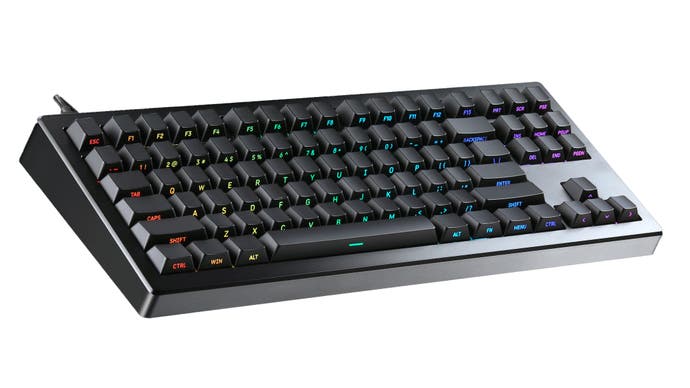
If you're particularly interested in deeper keyboard customisation but you don't want to build your own from scratch, the CSTM80 is a great way to explore some of the more trendy options available - and the resultant keyboard is certainly pleasant to use. However, there are many cheaper keyboards that offer a similarly good typing feel, including many options from Drop itself, so I'd say this keyboard isn't the best value option for anyone just acquainting themselves with mechanicals.
Mode Sonnet review: the nicest - and most expensive - keyboard I've ever used
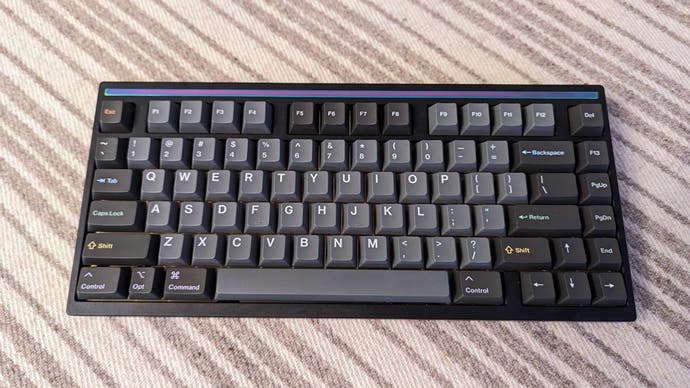
American firm Mode creates some unbelievably high-end keyboards and components, with their aluminium-chassis Sonnet keyboard starting at $299 without switches or keycaps and topping out at $851 (!!) with the most expensive options for things like weights, accent pieces and plates.
They sent out a pre-assembled review keyboard that costs $516 (!), with an aluminium weight in the base, a multi-colour metal accent along the top of the keyboard, hot-swap switch sockets mounted in a brass plate with plenty of foam, and their own Tomorrow PBT/ABS blend keycaps and Tomorrow Tactile factory lubed switches with Durock Gold V2 lubed/tuned stabilisers. (If you want to see what it looks like when being built, they happened to film it for Instagram.) The keyboard arrives in a lovely leather-ish hard case with space for the bundled cable, keyboard tools and extra switches.
As you can tell by that litany of options, the Sonnet is working along similar lines to the Drop CSTM80 we saw earlier in offering a very customisable keyboard for enthusiasts, but with access to significantly more expensive components and a few unique options. Even extremely avid keyboard enthusiasts would be lucky to have such sums to spend on a single mechanical keyboard, but the finished product is genuinely the nicest keyboard I've ever used.

It weighs an absolute ton - 1.8kg/4lbs by my scale - and produces a terrific racket at full bore, with the kind of deep, full sound that keyboard fans tend to crave. The lubricated, high-end switches and stabilisers result in a key press that feels extremely smooth throughout its travel, with a relatively high actuation force and prominent tactile bump that gives plain feedback that your stroke has been recognised.
The keyboard also looks fantastic, with the top accent piece, sculpted sides and subtle, stylish colours of the Tomorrow keycap set being the standout elements. I actually like that the keyboard doesn't come with RGB lighting either, as it fits that mature aesthetic and wouldn't shine through the offered keycaps anyway.
If you're well into your keyboards, the Sonnet could be worth a look. From my perspective, it feels like an end-game option - I honestly don't think I'm likely to try many more keyboards in my lifetime that can rival the Sonnet when it comes to typing feel, features and style, even as someone who's lucky enough to test out fancy keyboards as part of my job.
As always for anything that costs this much, I'd encourage you to read other reviews and feedback online before pulling the trigger. Thankfully, Mode's online configuration builder is excellent, showing you exactly what all of the various options look like on the keyboard from multiple angles, which ought to minimise the differences between expectations and reality.
Wrapping up
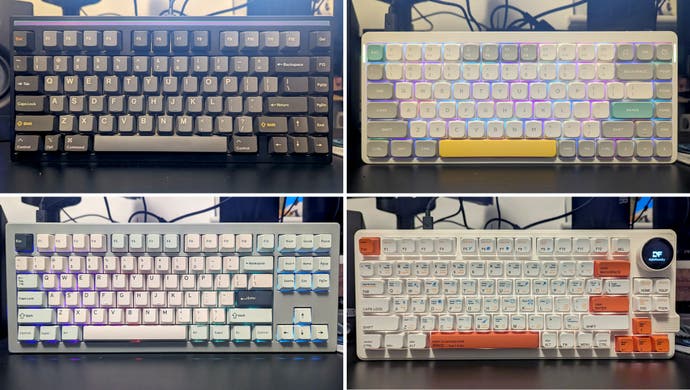
I didn't expect to see such a strong assortment of keyboards arrive in the latter quarter of the year, and I genuinely think that we'll see some of these now enthusiast elements appear in mainstream gaming keyboards as time goes on. It's happened before with gasket mounts, multi-function knobs and tiny screens, so surely more distinctly loud or quiet colourways, fancier plate mounts or added weights will pop up in a gaming board before too long?
I'm always slightly in the dark when it comes to writing these quite enthusiast round-ups for the Eurogamer audience, so do let me know in the comments if you find them fascinating, dull or helpful - it's always interesting to know, and you may help shape our future coverage.
